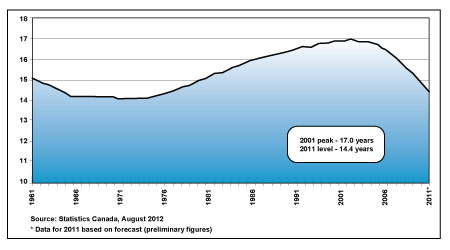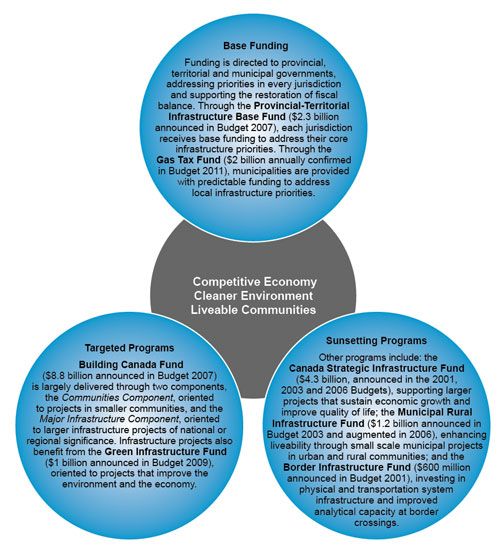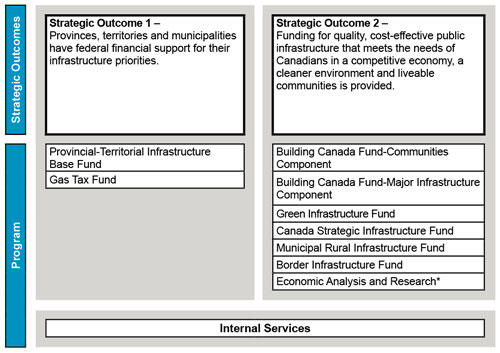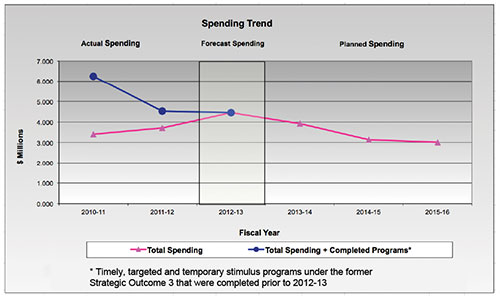Report on Plans and Priorities
2013-14 - Section 1
PDF Version (Size: 694.05 KB)
Help on accessing alternative formats, such as PDF, PPT and ZIP files, can be obtained in the alternate format help section.
Minister's Message

As Canada's Minister of Transport, Infrastructure and Communities, I am pleased to present Infrastructure Canada's Report on Plans and Priorities for 2013-14. The report outlines our ongoing work with other orders of government to build and improve public infrastructure to support long-term economic growth and sustainability across the nation.
We understand how vital infrastructure investment is to Canadian cities, towns, and communities. World-class public infrastructure from roads and public transit systems, to water works and environmental infrastructure such as waste disposal systems is essential for economic growth and the well-being of Canadians.
That's why this government has made infrastructure funding a priority. From the 2007 Building Canada plan, to the Economic Action Plan, to the development of a future long-term plan for public infrastructure, we have worked and will continue to work effectively with other levels of government to make meaningful and lasting infrastructure investments from coast to coast to coast.
These investments are not only building and revitalizing public infrastructure, they are helping to provide jobs. Since the government launched the Economic Action Plan in 2009, Canada has more than offset the jobs lost during the global economic downturn and has achieved the strongest job growth among G-7 countries over the recovery.
In 2013-14, Infrastructure Canada will build on the momentum of our past accomplishments, and focus our work in several key areas. This includes continuing to advance work on future programs for public infrastructure that will encourage greater private-sector involvement and public-private partnerships. They will be focused on affordability and sustainability over the long term, and will provide the best value for taxpayers.
We will also continue to deliver the Building Canada plan, which is continuing to provide significant funding for provincial, territorial and municipal infrastructure through programs such as the Gas Tax Fund. This fund has been made permanent at an unprecedented $2 billion annually; ensuring municipalities have the stable and predictable funding they need to support their local infrastructure priorities.
In doing all of this, Infrastructure Canada will continue to manage programs effectively and efficiently to ensure ongoing value for taxpayers. As we continue to deliver for communities and for Canadians, I invite you to follow our progress at Infrastructure Canada.
The Honourable Denis Lebel, P.C. , M.P.
Minister of Transport, Infrastructure and Communities and
Minister of the Economic Development Agency of Canada for the Regions of Quebec
Section I: Organizational Overview
1.1 Raison d'être
Modern, world-class public infrastructure is a key factor in achieving the Government of Canada's priorities of a stronger economy, a cleaner environment, and more prosperous, safer communities. Infrastructure Canada leads the Government of Canada's efforts in addressing Canada's public infrastructure challenges.
1.2 Responsibilities
I. Overview
Infrastructure Canada is the main department responsible for federal efforts to enhance Canada's public infrastructure through investments in provincial, territorial and municipal assets, engagement in key partnerships with the provinces, territories, municipalities, and the private sector, and the development and implementation of sound policies. Established in 2002, the Department provides funding support to provincial, territorial and municipal governments to ensure that Canadians benefit from world-class public infrastructure from coast to coast to coast.
Project Spotlight: Corridors for Canada

Project location: Northwest Territories
The Corridors for Canada Project is receiving a federal financial contribution of $65 million from the Canada Strategic Infrastructure Fund to support five major highway corridor improvement projects in the Northwest Territories (NT). Project work is focused on improving the safety, efficiency and reliability of transportation along important shipping routes serving the oil, gas and mining industries.
Along the Mackenzie Valley Winter Road between Wrigley and Norman Wells, ten permanent bridges are being built to replace the seasonal winter road bridges, thereby extending this key northern supply route. In addition, nearly 200-km of the Dempster Highway (Highway 8) between Inuvik and the Yukon-NT border; 36-km of the Yellowknife Highway (Highway 3) and Ingram Trail (Highway 4); were already reconstructed and repaved. Also reconstructed were approximately 38-km of the Liard Highway (Highway 7), from the British Colombia-NT border northward, and a 40-km length of the Mackenzie Highway (Highway 1), which also got new culverts to improve drainage.
These widespread improvements will greatly advance the capacity and safety of the transportation network of the region. Making these routes more efficient will deliver long-standing economic and social benefits.
The Government of Canada's investments in infrastructure over the past decade have leveraged funding from provinces, territories and municipalities, resulting in a significant overall increase in spending on municipally-owned, core public infrastructure as well as on provincial and territorial assets. Significant progress has been made. The average age of core public infrastructure is declining after years of trending upwards. From its peak of 17.0 years in 2001, the average age of core public infrastructure was down to 14.4 years in 2011.
In 2007, the Government of Canada launched the $33-billion Building Canada plan, the first ever federal long-term plan for infrastructure. Through the Building Canada plan, the Government of Canada is supporting thousands of projects in communities large and small that have given Canadians and communities access to better public infrastructure, provided local economic opportunities, and strengthened the national economy.
Furthermore, on December 15, 2011, Bill C-13 entitled Keeping Canada's Economy and Jobs Growing Act received Royal Assent, legislating the $2-billion annual Gas Tax Fund allocation permanently providing a source of long-term sustainable funding that municipalities can count on for their infrastructure needs now and in the future.
In 2013-14, the Department will continue to work to advance future programming for public infrastructure. At the same time, for the 2013-14 planning period, Infrastructure Canada will continue to oversee billions of dollars' worth of investments in infrastructure projects being delivered through existing programs that support a stronger economy, cleaner environment and prosperous communities.
Figure 1: Average Age of Core Public Infrastructure
II. Programs
Infrastructure Canada's funding programs address local and regional infrastructure needs, while advancing national priorities. This, in turn, makes Canada's economy stronger, keeps people and goods on the move, and helps to make our water and air cleaner. The Department delivers funding through various mechanisms:1
1.3 Strategic Outcomes and Program Alignment Architecture
Infrastructure Canada's Program Alignment Architecture structure has two Strategic Outcomes comprised of eight active Programs, as well as Internal Services, as detailed in Figure 2. Section II of this report provides additional detail on each program, including Internal Services, which supports all the programs.
Strategic Outcome 1 provides federal transfers to provincial, territorial and municipal governments for their infrastructure priorities in order to help maintain a high level of quality core public infrastructure across the country. Strategic Outcome 2 provides targeted project-specific investments to address federal/provincial/territorial priorities in large and small communities as well as large strategic investments of national and regional benefit. With the exception of the Gas Tax Fund, all of our programs are cost-shared with our partners, primarily other levels of government. All of our programs result in the construction and enhancement of public infrastructure, while contributing to broad federal government objectives of a competitive economy, a cleaner environment and liveable communities. These program design features are reflected in our performance measurement approach.
Figure 2: Program Alignment Architecture
* There is no planned spending for this Program beyond 2012-13. As such, it is not detailed in Section II of this report.
1.4 Organizational Priorities
Infrastructure Canada's organizational priorities for 2013-14 include the following:
| Priority | Type2 | Strategic Outcome(s) and/or Program |
|---|---|---|
| Negotiate funding agreements with partners to reflect permanent Gas Tax funding ($2 billion annually). | New | Strategic Outcome 1: Provinces, territories and municipalities have federal financial support for their infrastructure priorities. |
| Description | ||
Why is this a priority?
Plans for meeting the priority: The Department will require Treasury Board approval for the terms and conditions of the permanent Gas Tax Fund allocation, as set out in Bill C-13, and will work with partners to renew agreements allowing municipalities across the country to continue receiving stable, annual funding for infrastructure. |
||
| Priority | Type | Strategic Outcome(s) and/or Program |
|---|---|---|
| Work with funding partners in the continued implementation of existing programs, while providing prudent stewardship and oversight of these programs. | Ongoing |
|
| Description | ||
Why is this a priority?
Plans for meeting the priority: The Department will continue to work with provincial, territorial and municipal governments to identify new infrastructure projects, commit remaining funding and advance projects through the approval and funding agreement negotiation process, while ensuring continued prudent stewardship and oversight. The Department will ensure proper file closure for projects under the Building Canada plan and sunsetting programs are completed, including, as necessary, project and program audits and evaluations. The Department will also continue to work with its partners to ensure timely completion of projects. |
||
| Priority | Type | Strategic Outcome(s) and/or Program |
|---|---|---|
| Renew the Shared Information Management System for Infrastructure in preparation for future infrastructure programs. | New |
|
| Description | ||
Why is this a priority?
Plans for meeting the priority: The Department will conclude the Enterprise Data Warehouse Re-engineering project, which will increase sustainability and improve program reporting. This project is expected to deliver operational cost savings. The Department will work closely with Shared Services Canada to ensure the timely transfer of Shared Information Management System for Infrastructure to Shared Services Canada servers, and will enhance its internal capacity to deliver application services. |
||
| Priority | Type | Strategic Outcome(s) and/or Program |
|---|---|---|
| Work to develop future programming for public infrastructure that extends beyond the expiry of the Building Canada plan. | Previously committed to |
|
| Description | ||
Why is this a priority?
Plans for meeting the priority: Building on discussions with its partners and stakeholders during 2012, the Department is working to advance future programming for public infrastructure. New programs will help leverage new investments in infrastructure that promote growth and prosperity, while respecting taxpayers' ability to pay. |
||
| Priority | Type | Strategic Outcome(s) and/or Program |
|---|---|---|
| Pursue operational efficiencies in the effective delivery of the Department's mandate – prudent management, stewardship and implementation of its current suite of programs. | Previously committed to |
|
| Description | ||
Why is this a priority?
Plans for meeting the priority: Infrastructure Canada will continue to focus on prudent stewardship in the implementation of its existing programs, pursuing further cost efficiencies while working to stabilize the operational foundation of the Department. Infrastructure Canada will continue to systematically review direct program spending and operating costs to find efficiencies and reallocate funds in support of the government's overarching strategic review objective of management excellence and fiscal responsibility. As a result of the 2010 Strategic Review, the Department has identified savings opportunities to improve efficiency and the delivery of programs and services. Savings identified through the review totaled $124.5 million, comprised of administrative efficiencies, and a portion of unallocated program funding over a three-year period, concluding in 2013-14. |
||
1.5 Risk Analysis
1.5.1 Risk Management Approach
Infrastructure Canada systematically manages a variety of risks as it advances its strategic outcomes. As new environmental risk factors emerge and risk responses are implemented, the Department continues to apply a comprehensive approach to actively identify, assess and manage risks at the strategic, operational, program and project levels. This approach includes conducting regular environmental scans to identify internal and external risk factors, direct participation of the Department's executives in identifying and assessing key risks, and the development of adequate risk responses to achieve departmental priorities and advance strategic outcomes. This information is then captured in the Department's Corporate Risk Profile and semi-annual update reports. Finally, risk management is fully integrated into Infrastructure Canada's decision-making processes, and the lessons learned from these regular risk update exercises are embedded into the Department's culture at all working levels, enhancing program efficiency as well as stewardship.
The most recent update to the Corporate Risk Profile occurred in the summer of 2012 and reflects announcements in Budget 2012 including the potential impact of a future long-term plan for public infrastructure. Risk categories are derived from the Infrastructure Canada Risk Taxonomy and ranking is based on the likelihood of the risk and impact including potential consequences and existing risk responses.
1.5.2 Departmental Risks
The new Corporate Risk Profile lists six departmental risks that represent a significant change from the eight risks presented in the 2011 risk profile. This is attributed to the close-out of the Economic Action Plan infrastructure investment programs while continuing to deliver major programs such as the Building Canada Fund. For 2013-14, the following are the three highest ranked risks to the achievement of the Department's strategic outcomes:
i) The absence of an approved multi-year operating budget may impact Infrastructure Canada's capacity to fully deliver on its mandate.
As a key risk response, and recognizing that public infrastructure is an ongoing priority for the Government of Canada, Infrastructure Canada will continue to work with Central Agencies towards a resolution of this challenge.
ii) Infrastructure Canada may be unable to quickly and efficiently address information management and information technology challenges for new programs over the planning period.
Risk responses will include the fostering of a strong relationship with Shared Services Canada and the implementation of the Electronic Data Warehouse Re-engineering project.
iii) Infrastructure Canada may not be able to accurately plan for and maintain the right mix of skills in the right positions to address its uncertain mid- to long-term strategic needs.
The Department's risk responses will be addressed through the update and implementation of the Integrated Business and Human Resources Plan to support future programming for public infrastructure and the continued implementation of the existing suite of contribution programs such as the Building Canada Fund.
1.5.3 Risk Tolerance
Senior executives at Infrastructure Canada considered their tolerance level for each risk. In undertaking this activity, risk tolerance was defined as the willingness of the organization to accept or reject a given level of residual risk (exposure). It recognizes that clarity on risk tolerance at all levels of the organization is necessary to support informed risk taking and to foster risk-smart approaches to decision-making.
For 2013-14, all six key departmental risks were designated as "tolerable". This conclusion was derived from the fact that existing and additional risk responses were deemed adequate to manage the risks. It also recognized that, in some cases, the potential occurrence of the risk rests primarily outside the Department's control.
1.6 Planning Summary
Infrastructure Canada has supported thousands of provincial, territorial and municipal infrastructure projects under our programs, including the Building Canada plan, the Green Infrastructure Fund and sunsetting programs.
The Department will continue to make significant investments in 2013-14, with forecast spending of $3.9 billion towards construction of public infrastructure across the country. In 2013-14 and beyond, Infrastructure Canada will continue to work with funding partners to implement existing programs, ensure timely completion of projects and provide stewardship and oversight as we process and pay thousands of claims for projects. While delivering on this program mandate, and on the organizational priorities outlined in Section 1.4, the Department will ensure ongoing value for Canadians – pursuing further cost efficiencies by looking for ways to better administer and deliver programs. The Building Canada plan and sunsetting programs will continue to deliver results for communities well beyond 2014.
From coast to coast to coast, the Gas Tax Fund plays an important role in advancing infrastructure renewal. In 2013-14, Infrastructure Canada will continue to make available $2 billion annually through the Gas Tax Fund, providing municipalities with predictable funding to support environmentally sustainable municipal infrastructure that will contribute to desired outcomes of cleaner air, cleaner water and reduced greenhouse gas emissions. Through legislation passed in December 2011, the federal government has made this a permanent annual investment of $2 billion per year beyond 2014 to provide greater certainty for local infrastructure planning. As current agreements for this funding conclude in 2014, Infrastructure Canada will work with provinces and territories to renew agreements to allow municipalities across the country to receive stable, annual funding for their long-term infrastructure priorities.
Infrastructure Canada will also continue to lead the Government of Canada's efforts to address the public infrastructure needs of the country. Building on a history of successful and collaborative projects, Infrastructure Canada is committed to working with partners and stakeholders to improve public infrastructure across the country. In 2013-14, the Department will continue to work to advance future programming for public infrastructure for Canada. Any new programs will aim to ensure affordability and sustainability over the long term, and provide lasting benefits to Canadians, while respecting taxpayers' ability to pay.
1.6.1 Financial and Human Resources
Infrastructure Canada's financial and human resources information over the planning period are summarized in the two tables that follow.
Financial Resources (in $ thousands)
| Total Budgetary Expenditures (Main Estimates 2013-14) |
Planned Spending 2013-14 |
Planned Spending 2014-153 |
Planned Spending 2015-163 |
|---|---|---|---|
| 3,924,706 | 3,924,706 | 3,136,440 | 3,014,212 |
Human Resources (Full-Time Equivalents–FTE)
| 2013-14 | 2014-154 | 2015-164 |
|---|---|---|
| 331 | TBD | TBD |
Infrastructure Canada's full-time equivalents are managed flexibly. Employees are readily reallocated as needed during the year to reflect specific requirements of funding programs, operational requirements and other government priorities. Operating funding is also allocated to the administration of individual programs on a similar basis.
Infrastructure Canada does not have a regular and ongoing level of A-Base funding for departmental operational costs (e.g. salaries, operations and maintenance). Up to the end of 2012-13, the Department's entire operating budget has been sourced from its programs' funding envelopes, with annual funding for operational requirements fluctuating in response to the actual oversight and management necessary for active programs. For 2013-14, an operating budget was approved based on a source of funds provided through Budget 2012. Infrastructure Canada will continue to work with the Treasury Board Secretariat and Finance Canada to confirm operating funding for 2014-15 and future years.
1.6.2 Program by Strategic Outcome and Planned Spending
The planning summary table below identifies the planned spending and strategic outcomes for each departmental program, as well as the alignment of these Programs to the Government of Canada outcomes.
Planning Summary Tables (in $ thousands)5
| Strategic Outcome 1 | Program | Actual Spending 2010-11 | Actual Spending 2011-12 | Forecast Spending 2012-13 | Planned Spending | Alignment to Government of Canada Outcomes | ||
|---|---|---|---|---|---|---|---|---|
| 2013-14 | 2014-15 | 2015-16 | ||||||
| Provinces, territories and municipalities have federal financial support for their infrastructure priorities. | Provincial-Territorial Infrastructure Base Fund | 437,548 | 188,695 | 348,141 | 265,490 | 0 | 0 | Strong Economic Growth |
| Gas Tax Fund | 1,752,697 | 2,206,246 | 2,098,236 | 1,976,236 | 2,000,070 | 2,000,071 | Strong Economic Growth |
|
| Sub-Total: | 2,190,245 | 2,394,942 | 2,446,377 | 2,241,726 | 2,000,070 | 2,000,071 | ||
| Strategic Outcome 2 | Program | Actual Spending 2010-11 | Actual Spending 2011-12 | Forecast Spending 2012-13 | Planned Spending | Alignment to Government of Canada Outcomes |
||
|---|---|---|---|---|---|---|---|---|
| 2013-14 | 2014-15 | 2015-16 | ||||||
| Funding for quality, cost-effective public infrastructure that meets the needs of Canadians in a competitive economy, a cleaner environment and liveable communities is provided. |
Building Canada Fund-Communities Component | 225,825 | 213,884 | 218,608 | 188,734 | 115,418 | 213,005 | Strong Economic Growth |
| Building Canada Fund-Major Infrastructure Component | 407,499 | 759,828 | 1,130,814 | 942,955 | 612,324 | 547,498 | Strong Economic Growth |
|
| Green Infrastructure Fund | 35,430 | 30,274 | 160,970 | 125,030 | 89,646 | 81,249 | Clean and Healthy Environment | |
| Green Infrastructure Fund | 336,451 | 188,382 | 379,458 | 289,102 | 266,089 | 170,408 | Strong Economic Growth |
|
| Municipal Rural Infrastructure Fund | 146,646 | 88,043 | 57,644 | 78,763 | 0 | 0 | Strong Economic Growth |
|
| Border Infrastructure Fund | 67,881 | 35,042 | 23,354 | 22,965 | 51,032 | 0 | Strong Economic Growth |
|
| Economic Analysis and Research6 | 1,750 | 3,143 | 0 | 0 | 0 | 0 | Innovative and Knowledge-Based Economy | |
| Sub-Total: | 1,221,482 | 1,318,595 | 1,970,848 | 1,647,549 | 1,134,509 | 1,012,160 | ||
| Strategic Outcome 3 (Historic) |
Actual Spending 2010-11 | Actual Spending 2011-12 | Forecast Spending 2012-13 | Planned Spending | Alignment to Government of Canada Outcomes |
||
|---|---|---|---|---|---|---|---|
| 2013-14 | 2014-15 | 2015-16 | |||||
| Construction-ready infrastructure projects are provided with federal funding support7 (Includes timely, targeted and temporary stimulus programs under the 2009 Economic Action Plan, which were implemented between 2009 to 2011). |
2,790,799 | 771,049 | 0 | 0 | 0 | 0 | Strong Economic Growth |
| Sub-Total: | 2,790,799 | 771,049 | 0 | 0 | 0 | 0 | |
Planning Summary Table for Internal Services (in $ thousands)
| Program | Actual Spending 2010-11 | Actual Spending 2011-12 | Forecast Spending 2012-13 |
Planned Spending | ||
|---|---|---|---|---|---|---|
| 2013-148 | 2014-158 | 2015-168 | ||||
| Internal Services9 | 49,26510 | 55,52510 | 35,43010 | 35,43110 | 1,861 | 1,981 |
| Sub-Total: | 49,265 | 55,525 | 35,430 | 35,431 | 1,861 | 1,981 |
Planning Summary Total (in $ thousands)
| Strategic Outcomes, Programs and Internal Services | Actual Spending 2010-11 | Actual Spending 2011-12 | Forecast Spending 2012-13 | Planned Spending | ||
|---|---|---|---|---|---|---|
| 2013-14 | 2014-15 | 2015-16 | ||||
| Total | 6,251,791 | 4,540,110 | 4,452,655 | 3,924,706 | 3,136,440 | 3,014,212 |
1.7 Expenditure Profile
1.7.1 Spending Trends
In 2013-14, Infrastructure Canada has planned spending of $3.9 billion on infrastructure investments under its programs to meet the expected program results and contribute to its strategic outcomes.
Figure 3: Departmental Spending Trend
1.7.2 Variations in Program Spending Trends
In 2011-12, significant effort was dedicated to the scheduled closing out of two timely, targeted and temporary programs the Department was responsible for under the Economic Action Plan (EAP): the Infrastructure Stimulus Fund (ISF) and the Building Canada Fund-Communities Component Top-Up (BCF-CC Top-Up). At the same time, the Department continued to implement programs under the Building Canada plan.
Since 2009-10, the Department's spending continued to increase, peaking in 2010-11 with the implementation of the ISF and the BCF-CC Top-Up. From 2010-11 to 2013-14, the level of spending declines as the programs under the EAP were completed in 2011-12 (with the exception of the Green Infrastructure Fund, which extends beyond 2013). Beyond 2013-14, the Department will continue to flow funding towards the implementation of its existing programs under the Building Canada plan as well as the Green Infrastructure Fund. In addition, this graph does not include spending for future infrastructure programming as financial details are not yet available.
1.8 Estimates by Vote
For information on our organizational votes and/or statutory expenditures, please see the 2013-14 Main Estimates publication. An electronic version of the Main Estimates is available at: 2013-14 Main Estimates.
1.9 Contribution to the Federal Sustainable Development Strategy
The Federal Sustainable Development Strategy outlines the Government of Canada's commitment to improve the transparency of environmental decision-making. The strategy outlines key strategic environmental goals and targets, and ensures that they are considered in decision-making.
Although Infrastructure Canada is not one of the 27 departments required to table a Departmental Sustainable Development Strategy or to report on its contribution to the Federal Sustainable Development Strategy, it continues to play an important role in helping create a more sustainable future.
The Department's broad range of infrastructure programs supports thousands of projects across Canada that contribute to a cleaner environment in areas such as drinking water, wastewater, clean energy, public transit and brownfield redevelopment. Many of these infrastructure investments directly support two of the Federal Sustainable Development Strategy Themes:
- Maintaining Water Quality and Availability.
- Addressing Climate Change and Air Quality.
Beyond providing funding through federal infrastructure funding programs, Infrastructure Canada's measures support the Federal Sustainable Development Strategy's Theme 4, Shrinking the Environmental Footprint – Beginning with Government. The Department continues to implement its recent Greening Action Plan, which includes measures in green procurement, waste and energy reduction and awareness and promotion. More details on our green procurement initiatives can be found in the Supplementary Information Tables on Greening Government Operations, on Infrastructure Canada's website at: Infrastructure Canada Publications.
Project Spotlight: Major upgrades to drinking water treatment

Project location: Thetford Mines, Quebec
Thetford Mines is taking major steps to ensure its citizens enjoy high-quality drinking water for generations to come. Using $25.2 million from the Major Infrastructure Component of the Building Canada Fund, the Town is building a new filtration plant, renovating and upgrading its pumping and water storage facilities, installing new water supply system connections, and enhancing its protection of groundwater supply wells, among other work.
The project, one of the largest ever undertaken by the municipality, is making use of some innovative materials. The foundations, walls, columns, beams and structural slab of the chemical treatment ponds of the new plant will incorporate more than 67 kilometres of fibreglass reinforcement rod instead of traditional steel reinforcing bars. Fibreglass rods are lighter and do not react to chemicals, salt particles or the alkaline in concrete, thereby greatly reducing corrosion damage.
These fibreglass rods were in the past used only for road construction and military applications. By demonstrating potential alternative uses, this project could open up new markets for the local firm that manufactures them. As a result, not only will Thetford Mines residents enjoy improved water quality and reliability, the project could also stimulate the local economy and inspire innovative measures to increase the durability of concrete-based public infrastructure.
- Date modified:



